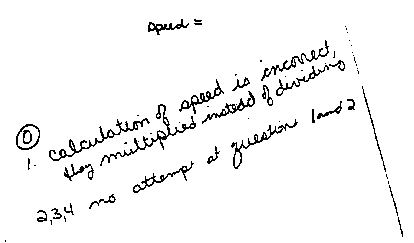Contributed by: Council of Chief State School Officers (CCSSO)
Here are examples for each score point ranging from 0 up to
4.
Event Score = 0
- Place the car back on the ramp exactly where you had marked
it before. Hold it in position with a pencil or ruler and release
it by lifting upward on the pencil or ruler. Start the stopwatch
when you release the car and stop the stopwatch when the car hits
the barrier.
- Measure the distance the barrier moved after the impact with
the car. (After the collision, measure the distance from the original
barrier front position to the center mark facing the ramp.)
- Repeat the procedure one more time and record your results in
Table 1.
- Your group now needs to design and perform a study that will
demonstrate how changes in the speed of the car affect the results
of the collisions between the car and the barrier. You should
test at least two other speeds. For each speed, perform two trials.
Record your results in Question 1.

Note: To calculate speed, divide the distance the
car traveled by the time on the stopwatch (S=D/T). To calculate
the average speed, add the speeds together and divide by two.
use this same method to calculate the average distance the barrier
moved.

- Discuss any conclusions that you may draw from the data
you collected. Include in your answer a discussion of whether
you believe your results are an accurate reflection of the
relationship between the speed of the car and the distance
the barrier moved. Be sure to justify your answer.

Go to Next Student Work
|
|

